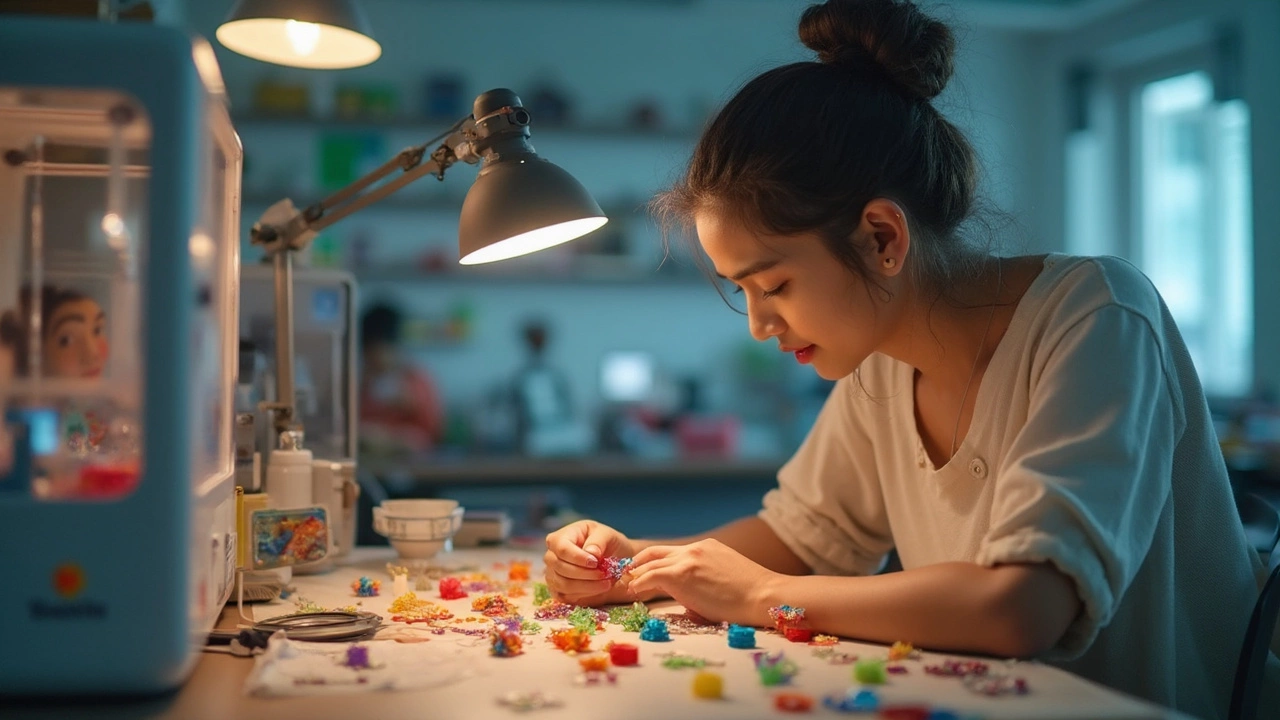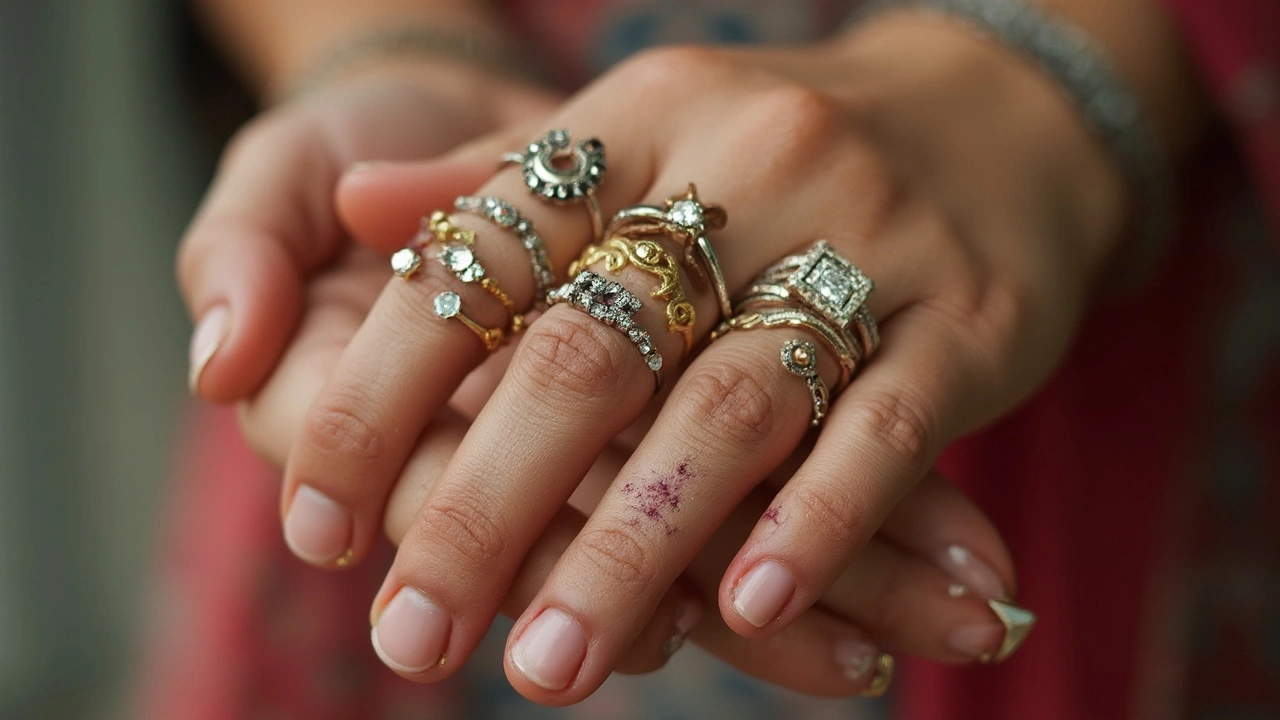
You walk into a craft fair or scroll through an online shop, spotting chunky, colorful rings and sculptural necklaces that look more like tiny works of art than something mass-produced. Your first thought? These must be 3D printed. But then another question creeps in: Is it actually safe to rock 3D printed jewelry all day, especially if you have sensitive skin or are gifting it to your kids like my Felix?
What Exactly Is 3D Printed Jewelry?
3D printed jewelry isn’t just another passing trend. These pieces are made using a process called additive manufacturing where a printer stacks ultra-fine layers of plastic, resin, metal, or other materials to bring even the wildest design to life. This freedom lets designers make shapes no traditional metalworker could dream up. And the appeal goes way beyond form. Want a necklace personalized with your name or a ring that looks like a city skyline? 3D printing can do it, and fast, often for less money than big-brand versions. According to the 2023 Global 3D Printing Jewelry Market Report, custom jewelry sales using 3D printing shot up by almost 22% over just the last three years. Kids love it for cosplay; adults get something one-of-a-kind.
The magic starts with a digital file, then moves into the real world layer by layer. Some printers use thermoplastics, which melt when heated and solidify as they cool (think PLA, ABS, or PETG). Others blast liquid resin with UV light so it hardens into dazzling detail. Then there’s the metal stuff—using precious powders fused by lasers. Each method comes with its own set of pros and cons, but safety always depends on what ingredients are in the mix and how cleanly things are finished post-printing.
Design isn’t limited by what you can carve or cast by hand. You’ll see intricate lattices and otherworldly shapes, feather-light but strong. Some designers print molds, then cast metal the old-school way, but full plastic or resin pieces are often wearable right off the printer after some polishing or coloring. It’s wild, but here’s the catch—no two pieces are quite the same, and that can be good or bad for your skin.
Unlike traditional jewelry, 3D prints can introduce surprising subtleties. Sometimes they’re layered so precisely, the seams vanish. Or, if the printer’s a little rough, you might get sharp bits that scratch. Most jewelry comes with these raw edges sanded or polished, but super-cheap prints from hobbyists or rushed manufacturers might skip those steps.
So, when buying or making 3D printed jewelry, always ask about the finishing process, what material was used, and if the designer actually wore a test piece. Those details clue you in to how safe or comfortable it’ll be.
Breaking Down the Safety Factors: Is There a Health Risk?
Let’s talk about the elephant in the room: if something is made with science-fiction technology, is your body cool with it touching your skin? That question comes up a lot—especially for parents or anyone with sensitive skin or metal allergies. The short answer is, it depends. Not every 3D printed piece is created equal, and a lot hinges on what material touches your body all day.
- Plastics (PLA, ABS, PETG): Most cheap 3D jewelry is made from PLA (polylactic acid), a plastic made from cornstarch. This sounds safe at first, and in most cases it really is—PLA is used in some medical devices and packaging. The main risk? Rough printing leaves tiny holes that can trap bacteria, sweat, or even soap. If you get a rash after wearing that cool ring, odds are it’s the surface, not the plastic itself, to blame. A study by the American Contact Dermatitis Society in 2022 flagged rough plastic jewelry as sometimes irritating for people with eczema.
- Resins: UV-cured resin jewelry is super detailed and popular. Here’s the thing—if the item isn’t cured all the way, leftover chemicals can leach out, causing itching or redness. Wash and finish are especially important. Some people react to even trace amounts of uncured resin—so if you know your skin is sensitive, think twice and ask the maker how they cleaned and cured the piece.
- Metals: High-end 3D printed jewelry is sometimes made of steel, titanium, silver, or gold, made possible by laser sintering or binder jetting. The headliner here: nickel allergies. Even stainless steel might contain trace nickel, which can trigger itchy breakouts for some. Pure titanium or 18k gold is usually hypoallergenic, but double-check what alloys are in the mix. Laser-sintered metal pieces are often smoother and less porous than plastic or resin, lowering bacterial buildup, but they’re not immune to rough edges from poor finishing.
- Colorants, Paints, and Added Finishes: This is a sleeper issue. Many 3D manufacturers or DIYers finish pieces with paint, powder coating, or dye to make them pop. These extra chemicals can sometimes be more irritating than the base material. Cheap or unsealed paints especially may flake off or bleed when your skin sweats.
So, does that all mean 3D printed jewelry is more dangerous than what you buy from the store? Not if it’s made thoughtfully—but it pays to know what you’re buying. I’ve seen some wild reactions circling on Reddit or parenting forums, and nine times out of ten, it’s cheap resin earrings or DIY prints where the making was rushed.
| Material | Common Risks | Safe for Sensitive Skin? |
|---|---|---|
| PLA Plastic | Bacterial buildup in pores | Usually, if polished/smooth |
| UV Resin | Uncured chemicals, leaching | Risky unless properly cured & washed |
| Stainless Steel | Nickel allergy | Sometimes |
| Titanium/Gold/Silver | Usually low, check alloys | Yes, often hypoallergenic |
| Painted/Dyed | Skin irritation from additives | Depends on paint/finish |
Want to hear it from a pro? Dr. Daniel Aires, a dermatologist at the University of Kansas Medical Center, told Parents Magazine last year:
"When considering any jewelry, whether 3D printed or not, ask yourself about the material, especially if it’ll be worn for long periods. Surfaces that trap moisture or rough edges can irritate the skin. For children, well-cured plastics and metals are safest, and unfinished resins should be avoided."

Smart Shopping: Tips for Picking Safe 3D Printed Bling
Truth is, you can sidestep almost every 3D printed jewelry mishap if you shop and care for it the right way. I deal with this as a dad with a kid who’s into superhero cosplay—and nothing’s worse than your kid getting a rash because you bought the cool dragon earrings from some random Etsy shop. Here are some tips I wish I knew before:
- Ask for Details: If you’re buying from a maker or small business, shoot them a message. Ask what the piece is made from, if it’s been washed, polished, or sealed, and how they finish off prints. Any shop worth its salt will be happy to give you specifics.
- Check for Rough Edges: This one’s basic, but lots of people forget it. Run your fingers around the inside of rings or along chain links. Any sharp or rough section needs to be sanded or polished more. Blame the print layers if it feels weird, not your skin.
- Avoid Uncured Resin (Especially for Kids): If the jewelry is made from resin, check reviews for complaints about residue or smell—bad signs. Most big sellers post videos of their finishing process to prove it's safe.
- Metal Allergies? Go Hypoallergenic: If you, like me, break out from cheap metals, just pay extra for pure titanium, gold, or a labeled hypoallergenic alloy. Don’t assume metal means safe—always ask.
- Clean Before Wearing: Even if a piece looks finished, give it a quick wash in warm, soapy water, and dry it well. This knocks down both extra printing residue and leftover dust from the shop.
- Be Wary of Cheap Painted Jewelry: Painted pieces might look neon-bright, but if you see paint rubbing onto your skin or flaking off, stop wearing it. Only stick with sellers who use proven, sealed paints meant for skin contact.
- Rotate Your Jewelry: Don’t wear the same piece for days on end. Change things up so no part of your skin gets irritated from prolonged contact—especially in the summer when sweat gets trapped under bracelets or chunky rings.
I get tempted by those glow-in-the-dark kids’ necklaces too, but Felix only gets ones after I do a smell and touch test. No weird smell? No powdery residue? No weird itching after 10 minutes? Then it passes.
Gifting or buying for younger kids? Triple-check the size and whether tiny parts could come loose. Some 3D designs have intricate moving parts, but loose links could spell a choking risk. Also, never let babies chew on any 3D printed jewelry—the plastics aren’t meant for constant gnawing like a teething ring.
Future-Proofing: How Tech and Regulations Influence Jewelry Safety
3D printed jewelry is getting safer every year, mostly because as it’s gotten more popular, buyers have gotten less tolerant of shoddy quality and makers have had to step up their game. Major materials suppliers now offer hypoallergenic blends of PLA and resins, some even with antimicrobial infusions for people with recurring skin problems. And polishing techniques keep improving, meaning smoother, safer pieces fresh off the printer.
There’s also more pressure on sellers to be transparent, especially on big platforms like Etsy, Amazon Handmade, or Shapeways. In Europe, regulations are tight—the EU bans certain toxic chemicals and requires traceability for all wearable goods, including 3D printed ones. In the US, the FDA and CPSC have started tracking plastics and finishes used in jewelry if the pieces are meant for kids, so you’ll rarely see a responsible shop shipping raw resin pendants without safety info. Still, you sometimes need to dig for this info on small creator sites.
This push for clarity has led to labeling changes. More sellers now specify: "nickel-free," "medical-grade PLA," or "fully cured and hand-washed" on listings. Some have started offering QR codes linking to the exact print file, material batch, and cleaning details. This level of honesty is a win, especially if you get hives from nickel or mystery plastics like I do sometimes.
How about sustainability? An underrated perk of most 3D prints is how little waste they create compared to carved or cast jewelry. That’s great news if you want less junk going to landfill. Some brands now only use fully biodegradable PLA or offer take-back programs for broken pieces.
If you’re crafty and plan to print at home, keep your work area well-ventilated, wear gloves if handling uncured resin, and wash or seal finished bits before letting anyone wear them. Even hobbyists are swapping old-school ABS for newer blends that are safer and less likely to irritate skin, especially on little ones.
So—while 3D printed jewelry isn’t zero-risk, if you stick with reputable makers, double-check the materials, and avoid handling raw pieces, the odds are in your favor for a stylish, safe accessory. Just don’t forget: your skin will always tell you if something’s wrong, so listen to it—and be pickier than you think you need to be. That weird itch after the third hour? Swap it out. There’s too much awesome, safe stuff out there to settle for less.


